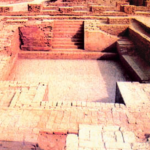TOPIC: Indian culture will cover the World Heritage salient aspects of Art Forms, Literature and Architecture from ancient to modern times.
In news
- The 40th session of the World Heritage Committee held in Istanbul, Turkey (2016) has added new sites to the World Heritage List.
- Three sites from India have been included in the list.
- The ruins of the ancient Nalanda University of Bihar, the Khangchendzonga National Park (KNP) of Sikkim and the Capitol Complex of Chandigarh.
- The Capitol Complex houses the Legislative Assembly, the High Court and the Secretariat.
- The KNP is the first mixed site from India.
- A mixed site has features of both cultural as well as natural heritage.
- India now has a total of 35 sites in the list. ( 27 cultural, 7 natural, 1 mixed).
What is the World Heritage Convention?
- The World Heritage Convention was proposed at the request of members of the United Nations Educational, Scientific and Cultural Organization (UNESCO) and was adopted by it.
-
The most significant feature of the 1972 World Heritage Convention is that it links together in a single document the concepts of nature conservation and the preservation of cultural properties.
The Convention recognizes the way in which people interact with nature, and the fundamental need to preserve the balance between the two.
What is the World Heritage Committee?
- The World Heritage Committee, formed in 1977, the main body in charge of the implementation of the Convention, has developed precise criteria for the inscription of properties on the World Heritage List and for the provision of international assistance under the World Heritage Fund.
- The World Heritage Committee meets once a year, and consists of representatives from 21 of the States Parties to the Convention elected by their General Assembly.
- The Committee defines the use of the World Heritage Fund and allocates financial assistance upon requests from States Parties.
- It also decides on the inscription or deletion of properties on the List of World Heritage in Danger.
- It has the final say on whether a property is inscribed on the World Heritage List.
- It examines reports on the state of conservation of inscribed properties and asks States Parties to take action when properties are not being properly managed.
Which are the advisory bodies to the Committee?
- Three international non-governmental or intergovernmental organizations are named in the Convention to advise the Committee in its deliberations.
- 1. ICCROM- International Centre for the Study of the Preservation & Restoration of Cultural Property (1956- Rome).
- 2. ICOMOS- The International Council on Monuments & Sites. (1965- Secretariat in Paris)
- 3. IUCN
Who are the members of the Convention?
- There are 192 state parties to the convention as of June 2016, with South Sudan being the latest addition.
- States Parties are countries which have adhered to the World Heritage Convention.
- India became a state party in 1977.
- They thereby agree to identify and nominate properties on their national territory to be considered for inscription on the World Heritage List.
- When a State Party nominates a property, it gives details of how a property is protected and provides a management plan for its upkeep.
- States Parties are also expected to protect the World Heritage values of the properties inscribed and are encouraged to report periodically on their condition.
What is the World Heritage Fund?
- Article 15 of the Convention concerning the Protection of the World Cultural and Natural Heritage, establishes a Fund, called “the World Heritage Fund”
-
The financial resources for the conservation and protection of World Heritage sites include the World Heritage Fund, which receives most of its income from compulsory contributions from States Parties and from voluntary contributions. Other sources of income include profits derived from sales of World Heritage publications, or funds-in-trust that are donated by countries for specific purposes.
The World Heritage Fund amounts to US$3 million annually to support activities decided by the World Heritage Committee, related to International Assistance,State of Conservation and Nominations.
The World Heritage Committee allocates funds according to the urgency of requests, priority being given to the most threatened sites.
What is the selection criteria to find a place in the list?
- To be included on the World Heritage List, sites must be of outstanding universal value and meet at least one out of ten selection criteria.
1. to represent a masterpiece of human creative genius;
2. to exhibit an important interchange of human values, over a span of time or within a cultural area of the world, on developments in architecture or technology, monumental arts, town-planning or landscape design;
3. to bear a unique or at least exceptional testimony to a cultural tradition or to a civilization which is living or which has disappeared;
-
Sites can only be nominated by the country in which they are located. Areas nominated by their own countries are evaluated by the Intergovernmental Committee for the Protection of the World Cultural and Natural Heritage, known as the World Heritage Committee. The World Heritage Committee, upon determining that a site meets the criteria for inclusion on the World Heritage List, inscribes the site on the List. It receives assistance from expert international groups in its evaluations.
Indian Sites on the World Heritage List1. Cultural Sites– 27 -
Agra fort
-
Ajanta Caves
-
Archaeological Site of Nalanda Mahavihara (Nalanda University) at Nalanda, Bihar (2016)
-
Buddhist Monuments at Sanchi
-
Champaner-Pavagadh Archaeological Park
-
Chhatrapati Shivaji Terminus (formerly Victoria Terminus)
-
Churches and Convents of Goa
-
Elephanta Caves
-
Ellora Caves
-
Fatehpur Sikri
-
Great Living Chola Temples
-
Group of Monuments at Hampi
-
Group of Monuments at Mahabalipuram
-
Group of Monuments at Pattadakal
-
Hill Forts of Rajasthan
-
Humayun’s Tomb, Delhi
-
Khajuraho Group of Monuments
-
Mahabodhi Temple Complex at Bodhgaya
-
Mountain Railway of India
-
Qutub Minar and its Monuments
-
Rani-ki-Vav (the Queen’s Stepwell) at Patan, Gujarat
-
Red Fort Complex
-
Rock Shelters of Bhimbetka
-
Sun Temple, Konark
-
Taj Mahal
-
The Architectural Work of Le Corbusier (Capitol Complex), an Outstanding Contribution to the Modern Movement (2016)
-
The Jantar Mantar (Jaipur)
2. Natural Sites- 7
-
Great Himalayan National Park Conservation Area
-
Kaziranga National Park
-
Keoladeo National Park
-
Manas Wildlife Sanctuary
-
Nanda Devi and Valley of Flowers National Parks
-
Sundarbans National Park
-
Western Ghats
- Khangchendzonga National Park (2016)
-
The List of World Heritage in Danger is designed to inform the international community of conditions which threaten the very characteristics for which a property was inscribed on the World Heritage List, and to encourage corrective action.
Armed conflict and war, earthquakes and other natural disasters, pollution, poaching, uncontrolled urbanization and unchecked tourist development pose major problems to World Heritage sites.
Dangers can be ‘ascertained’, referring to specific and proven imminent threats, or ‘potential’, when a property is faced with threats which could have negative effects on its World Heritage values.
Inscribing a site on the List of World Heritage in Danger allows the World Heritage Committee to allocate immediate assistance from the World Heritage Fund to the endangered property.
There are 55 such properties which have been included in this list. None of the sites belong to India.What are the benefits of the World Heritage Listing?
- Since World Heritage Sites are recognized as internationally important, international organizations often give priority to World Heritage Sites in making financial grants and providing technical assistance.
- When a country nominates an area for the listing, it commits to protect that site in the future. This means that national governments and foundations also emphasize World Heritage Sites in their own allocations of funding and assistance.
- The listing conveys upon the sites a stature that announces to the world how precious and important, and worth visiting, a country’s heritage resources are.
- This international cooperation recognizes that no country has the intellectual or financial resources to address all its conservation and preservation concerns alone. Through voluntary cooperation, all countries can do a better job of stewarding their own heritage resources.











